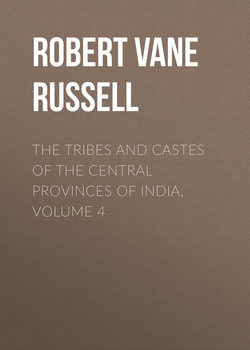Читать книгу The Tribes and Castes of the Central Provinces of India, Volume 4 - Robert Vane Russell - Страница 61
Part II
Articles on Castes and Tribes
Kumhār—Yemkala
Vol. IV
Kurmi
22. Burning the dead
ОглавлениеAt the cremation-ground the corpse is taken from the bier and placed on the pyre. The cloth which covered it and that on which it lay are given to a sweeper, who is always present to receive this perquisite. To the corpse’s mouth, eyes, ears, nostrils and throat is applied a mixture of barley-flour, butter, sesamum seeds and powdered sandalwood. Logs of wood and cowdung cakes are then piled on the body and the pyre is fired by the son, who first holds a burning stick to the mouth of the corpse as if to inform it that he is about to apply the fire. The pyre of a man is fired at the head and of a woman at the foot. Rich people burn the corpse with sandalwood, and others have a little of this, and incense and sweet-smelling gum. Nowadays if the rain comes on and the pyre will not burn they use kerosine oil. When the body is half-consumed the son takes up a piece of wood and with it strikes the skull seven times, to break it and give exit to the soul. This, however, is not always done. The son then takes up on his right shoulder an earthen pot full of water, at the bottom of which is a small hole. He walks round the pyre three times in the direction of the sun’s course and stands facing to the south, and dashes the pot on the ground, crying out in his grief, ‘Oh, my father.’ While this is going on mantras or sacred verses are recited by the officiating Brāhman. When the corpse is partly consumed each member of the assembly throws the Pānch lakariya (five pieces of wood or sprigs of basil) on to the pyre, making obeisance to the deceased and saying, ‘Swarg ko jao,’ or ‘Ascend to heaven.’ Or they may say, ‘Go, become incarnate in some human being.’ They stay by the corpse for 1¼ pahars or watches or some four hours, until either the skull is broken by the chief mourner or breaks of itself with a crack. Then they bathe and come home and after some hours again return to the corpse, to see that it is properly burnt. If the pyre should go out and a dog or other animal should get hold of the corpse when it is half-burnt, all the relatives are put out of caste, and have to give a feast to all the caste, costing for a rich family about Rs. 50 and for a poor one Rs. 10 to Rs. 15. Then they return home and chew nīm leaves, which are bitter and purifying, and spit them out of their mouth, thus severing their connection with the corpse. When the mourners have left the deceased’s house the women of the family bathe, the bangles of the widow are broken, the vermilion on the parting of her hair and the glass ornament (tikli) on her forehead are removed, and she is clad in white clothing of coarse texture to show that henceforth she is only a widow.
On the third day the mourners go again and collect the ashes and throw them into the nearest river. The bones are placed in a silken bag or an earthen pot or a leaf basket, and taken to the Ganges or Nerbudda within ten days if possible, or otherwise after a longer interval, being buried meantime. Some milk, salt and calfs urine are sprinkled over the place where the corpse was burnt. These will cool the place, and the soul of the dead will similarly be cooled, and a cow will probably come and lick up the salt, and this will sanctify the place and also the soul. When the bones are to be taken to a sacred river they are tied up in a little piece of cloth and carried at the end of a stick by the chief mourner, who is usually accompanied by several caste-fellows. At night during the journey this stick is planted in the ground, so that the bones may not touch the earth.
